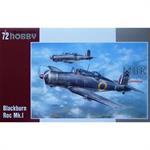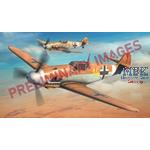Blackburn Roc Mk.I
SH72141
Special Hobby
1:72
Similar to the land-based Defiant fighter, the new fighter's armament was to be concentrated in a manned turret.
Blackburn's chief designer, G.E. Petty, delivered the so-called B.25 design, which was closely related to the previous B.24 design, also known as the Skua Mk.II.
It was an all-metal, low-wing monoplane with folding wings and retractable landing gear.
The fuselage, including the Perseus XII engine, was adopted from the Skua.
The only modification was the widening of the fuselage behind the pilot's cockpit to accommodate the rotating Boulton Paul Mk.II turret with four machine guns.
On April 28, 1937, long before the prototype's first flight, production of 136 aircraft was ordered.
The first prototype took off on December 23, 1938. The prototype was tested without the turret in place, which was fitted to the subsequent prototype, L3058.
Due to Blackburn's commitment to the Skua and preparations for production of the Botha bomber, production of the Roc was handed over to Boulton Paul, which built 133 production aircraft designated Roc Mk.I.
The first aircraft was produced in early 1939 and delivered to Nos. 800 and 803 Squadrons of the FAA from April onwards. Later, Nos. 801 and 806 Squadrons were also re-equipped with Rocs.
Nevertheless, none of the above-mentioned squadrons were exclusively equipped with Rocs, which were always simply a supplement to the more capable Skua Mk.II type.
Some Rocs were delivered, but before the outbreak of war, they were modified and transferred to training and target-towing units.
Their performance was unsatisfactory due to the machine gun turret, and the Roc was 300 kg heavier than the already underpowered Skua.
When the war broke out, three Rocs from Nos. 801 and 803 Squadrons were operating aboard the Ark Royal, later flying from Hatson Air Base in the Orkney Islands.
Later, in 1940, Rocs from Nos. 801 and 806 Squadrons were deployed over Western Europe.
During this period, only one success and one loss occurred.
A Roc with serial number L3065 probably shot down a Ju 88 along with two Skuas.
From June 1940, the Rocs began to be withdrawn from combat units and transferred to second-line units for training and target towing.
Because Stalin's Soviet Union attacked Finland, it was decided in 1940 to sell 30 aircraft to Finland as part of an aid policy for Finland.
Upon delivery, the aircraft were given Finnish insignia and serial numbers.
They were not delivered until the end of the Winter War, and there was no further interest in this type afterward.
There is evidence that these aircraft flew under the Finnish flag in Great Britain, although the Finnish insignia was obscured.
Plastic model kit
- with photo-etched parts
- with resin parts
unbuilt / unpainted
Paint and glue not included
Write now your personal experience with this article and help others with their purchase decision.






